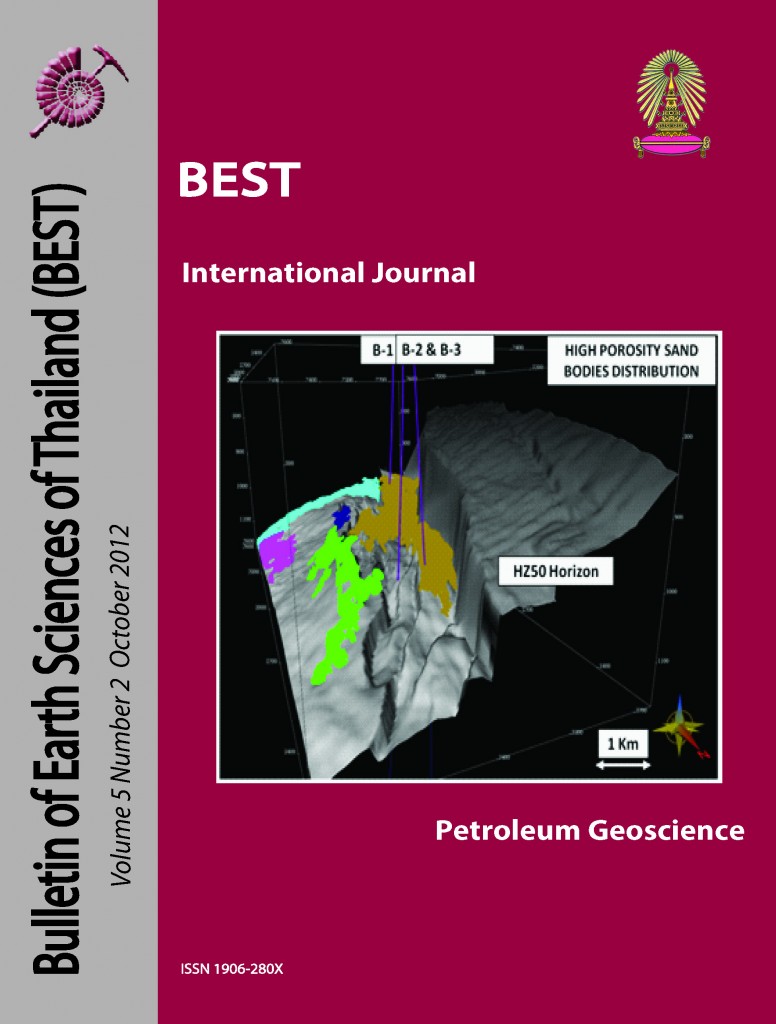Structural Analysis, Hydrothermal Brecciation & Diagenesis in a Permian Limestone Outcrop in the Krabi Province, Southern Thailand
Main Article Content
Abstract
Some 8km WNW from the Krabi international airport is the studied quarry, which gives fresh exposures of heavily faulted Permian Ratburi limestone. Satellite image analysis of the surrounding area shows NW-SE, N-S and NE-SW as major lineament trends. These trends are in part related to movements of the Klong Marui Fault, which is a major regional periodically-reactivated strike-slip fault system. It cuts across this region of Thailand and defines much of dominant modern structural grain in the Thai Peninsula, including the study area. Field mapping in the quarry reveals strike-slip faulting, showing earlier E-W orientations evolving to NNE-SSW orientations. Also mapped are associated calcite-filled fracture trends made up of N-S, NW-SE, NE-SW and E-W that were expressed in planar, mesh and en-echelon fracture sets. The change in σ1 from E-W to N-S is interpreted as a Paleogene response to the ongoing influence of the northward movement of Indian terrane and the Himalayan Orogeny. Regional magmatic activity in the late Cretaceous and Eocene triggered phreatic water heating, which were the precursor to hydrothermal circulations. Two episodes of non-radiogenic high temperature and high pressure hydrothermal fluids precipitated calcite with three styles of porosity-occluding cements (syntaxial, bladed and drusy) growing in and around the mapped faults and fractures, which also host many of the hydrothermal breccias exposed in the quarry. Despite pervasive calcite cementation related to the earlier fracture sets, two types of open porosity remain in the quarry in response to; 1) pressure release due to unroofing of the limestone, creating open joint sets and, 2) a weakly developed set of fracture porosities made by distal effects of Oligocene rifting creating open fractures tied to normal faults. Chumpon Basin lies to the east of the quarry and offshore of the peninsula, with the Klong Marui fault serving as the western boundary to the basin. The Nang Nuan Oilfield, in Chumpon Basin, is a hydrothermal karst play controlled by deep-rooted faults and fractures. The field and the prediction of high production zones suffer from poor understanding of the influence of faults and hydrothermal cements, which has lead to the current erratic production returns in the field. Hydrocarbons are produced from open fractures in the field, but same fractures have variablycemented patchy porosity and it is likely that there is also a Tertiary-age subaerial exposure surface in the field situated at the top Permian and separating the underlying fractured Ratburi reservoir host from the overlying Tertiary seal. Other than the Tertiary cap, similar elements are found in studied outcrop, making it a good analogue for many aspects of the offshore Permian carbonate play.
Article Details

This work is licensed under a Creative Commons Attribution-NonCommercial-NoDerivatives 4.0 International License.
Copyright © 2008 Department of Geology, Faculty of Science, Chulalongkorn University. Parts of an article can be photocopied or reproduced without prior written permission from the author(s), but due acknowledgments should be stated or cited accordingly.
References
Adams, A., MacKenzie, W., & Guilford, C. 1984. Atlas of sedimentary rocks under the microscope. Longman Scientific & Technical, 106pp.
Antonellini, M.A., Aydin, A. 1994. Effects of faulting on fluid flow in porous sand stones: petrophysical properties. American Association of Petroleum Geologists Bulletin, 78, p.355–377.
Charusiri, P. 1989. Lithophile metallogenetic epochs of Thailand: A geological and geo-chronological investigation. PhD thesis, Queen’s University, Kingston, Canada, 819pp.
Cuong, T.,X., & Warren, J., K. 2009. Bach Ho Field, a fractured granitic reservoir, Cuu Long Basin, Offshore SE Vietnam: A “Buried Hill” Play. Journal of Petroleum Geology, 32, 129-156.
Department of Mineral Resources(DMR). (1985). Geological Map of Thailand, Scale 1:250,000. Geological Survey Division, DMR, Bangkok.
Department of Mineral Resources(DMR). (2008). Geological Map of Thailand, Scale 1:250,000. Geological Survey Division, DMR, Bangkok.
Hansen, B., & Wemmer, K. 2011. Age and evolution of the basement rocks in Thailand. In M.F. Ridd, A.J. Barber, & M. J. Crow (Eds.), The Geology of Thailand. The Geological Society of London, p. 19-32.
Heward, A., Chuenbunchom, S., Makel, G., Marsland, D. & Spring, L. 2000. Nang Nuan oilfield, B6/27, Gulf of Thailand: karst reservoirs of meteoric or deep burial origin?, Geological Society of London Special Publication, 6, p.15-27.
Kanjanapayont, P. 2002. Geological structural model illustrated by the Mesozoic stratigraphic units in the upper southern Thailand, with special reference to Changwat Krabi and Surat Thani. Master Thesis, Chulalongkorn University, 103pp.
Kanjanapayont, P. 2009. Structural analysis and geochronology of the Klong Marui fault, southern Thailand. PhD Thesis, Vienna University, Austria, 137pp.
Kanjanapayont, P., Grasemann, B., Edwards, M., Fritz, H. 2012. Quantitative kinematic analysis within the Klong Marui shear zone, southern Thailand. Journal of Structural Geology, 35, p.17-27.
Lousuwan, K. 2005. Hydrothermal karst in the Nang Nuan oilfield, Gulf of Thailand. Master Thesis, University of Brunei Darussalam, 84pp.
Morley, A., & Racey, A. 2011. Tertiary Stratigraphy. In M.F. Ridd, A.J. Barber, & M. J. Crow (Eds.), The Geology of Thailand. The Geological Society of London, p.223-271.
Royal Thai Survey Dept. 2000. Geological Map of Thailand, Scale 1:50,000. Geological Survey Division, DMR, Bangkok.
Watkinson, I., Elders, C. & Hall, R. 2008. The kinematic history of the Klong Marui and Ranong Faults, southern Thailand, Journal of Structural Geology, 30, p.1554-1571.


